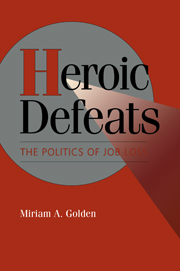Book contents
- Frontmatter
- Contents
- Preface
- List of Abbreviations
- Chapter 1 The Puzzle of Union Responses to Workforce Reductions
- Chapter 2 Games Analyzing Job Loss
- Chapter 3 Job Loss in the Italian and British Automobile Industries
- Chapter 4 Triggers of Industrial Action
- Chapter 5 Pit Closures in the Japanese and British Mining Industries
- Chapter 6 Seeking Allies: How Other Actors Affect Interactions over Job Loss
- Chapter 7 Conclusions
- Notes
- References
- Index
Chapter 2 - Games Analyzing Job Loss
Published online by Cambridge University Press: 20 January 2010
- Frontmatter
- Contents
- Preface
- List of Abbreviations
- Chapter 1 The Puzzle of Union Responses to Workforce Reductions
- Chapter 2 Games Analyzing Job Loss
- Chapter 3 Job Loss in the Italian and British Automobile Industries
- Chapter 4 Triggers of Industrial Action
- Chapter 5 Pit Closures in the Japanese and British Mining Industries
- Chapter 6 Seeking Allies: How Other Actors Affect Interactions over Job Loss
- Chapter 7 Conclusions
- Notes
- References
- Index
Summary
In Chapter 1, I presented the assumptions that underlie the game-theoretic analysis of job loss as well as the major results derived from that analysis. The goal was to acquaint the reader with the substantive logic of the games. The current chapter presents the games themselves. A second section discusses the rationale for case selection.
THE SIMPLE JOB LOSS GAME
The simplest possible interaction over workforce reductions is represented in Figure 2.1. The firm announces that job loss is required and has to decide whether to target union activists or not. Since the firm moves first, it is known as Player 1. If the firm targets activists, the union has to decide whether to strike or not. Since it moves second, the union is Player 2. The payoffs for each player are listed in order (Player 1, Player 2) at the three terminal nodes of the game.
The three assumptions presented in Chapter 1 allow us to order the payoffs for each player. There we said that the firm's most preferred outcome is to target activists and not face a strike (b1). The reason, as the reader will recall, is that we assumed that firms wanted to exploit mass workforce reductions to target trade union representatives, thereby undermining union organization. However, firms were not prepared to pay the costs of a strike if one ensued. The firm's second most preferred outcome is simply not to target activists at all (c1).
- Type
- Chapter
- Information
- Heroic DefeatsThe Politics of Job Loss, pp. 28 - 39Publisher: Cambridge University PressPrint publication year: 1996



